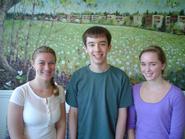
When most people hear the term global climate change, they automatically think of global warming. Although the greenhouse gases in the atmosphere certainly increase temperatures by absorbing radiation from the sun, the global warming they cause can also contribute to global cooling. As temperatures rise, more water enters the atmosphere via evaporation. Once in the air, these water molecules may cluster into aerosols (airborne solid particles), forming clouds that reflect solar radiation and cause a cooling effect. Understanding how and why these water clusters form is therefore an important component to understanding global climate change. To accomplish this task, Alexa Ashworth '09 (Pittsford, N.Y.), Tom Morrell '10 (Randolph, N.J.), and Elena Wood '10 (Ridgefield, Conn.) are studying the formation of water clusters with different aerosol cores. The project is a continuation of ongoing research in the computational chemistry lab of George Shields, Winslow Professor of Chemistry, and Karl Kirschner, co-director of the Center for Molecular Design.
To carry out their research, the team takes a particular aerosol core, adds water molecules to it, and performs various calculations on the system to see whether cluster formation will occur. Each member of the team has been assigned a different aerosol core: Ashworth studies HSO4-, Morrell studies NH4, and Wood studies H2SO4. The team members begin by carrying out a molecular dynamics simulation, which shows how the molecules move around in the cluster systems. They take the results from these preliminary calculations and use them to perform higher-level calculations, which reveal the lowest energy configurations for the clusters. Ashworth, Morrell, and Wood are also able to use their results to predict how many clusters will form under certain environmental conditions. Initially, the team began with small systems containing one to four molecules, but they have since moved to larger systems. Calculations involving these large clusters have not been done before because they are computationally difficult.
Although all three team members have found their summer research to be a rewarding experience, they also agree it has presented many challenges. They had to learn the computer programs, familiarize themselves with chemistry lingo, determine which calculations are the best, and figure out what to do next when their calculations didn't run as expected (which, they admit, happened quite frequently).
Ashworth began working on this project last summer. She is a chemistry major and French minor. Ashworth is a member of the step team, plays the flute, and belongs to the Kappa Sigma Alpha sorority. Morrell, a chemistry major, is also in his second summer of research. In addition to playing in the orchestra and working in the tech crew, he regularly engages in various service and outdoor activities. This is Wood's first summer of research. She plans on double majoring in chemistry and either creative writing or dance. On campus, Wood is involved in Tropical Sol (a Latino dance group), HEAT (a hip-hop troupe) and works in the admissions office and fitness center.
-- by Nick Berry '09
To carry out their research, the team takes a particular aerosol core, adds water molecules to it, and performs various calculations on the system to see whether cluster formation will occur. Each member of the team has been assigned a different aerosol core: Ashworth studies HSO4-, Morrell studies NH4, and Wood studies H2SO4. The team members begin by carrying out a molecular dynamics simulation, which shows how the molecules move around in the cluster systems. They take the results from these preliminary calculations and use them to perform higher-level calculations, which reveal the lowest energy configurations for the clusters. Ashworth, Morrell, and Wood are also able to use their results to predict how many clusters will form under certain environmental conditions. Initially, the team began with small systems containing one to four molecules, but they have since moved to larger systems. Calculations involving these large clusters have not been done before because they are computationally difficult.
Although all three team members have found their summer research to be a rewarding experience, they also agree it has presented many challenges. They had to learn the computer programs, familiarize themselves with chemistry lingo, determine which calculations are the best, and figure out what to do next when their calculations didn't run as expected (which, they admit, happened quite frequently).
Ashworth began working on this project last summer. She is a chemistry major and French minor. Ashworth is a member of the step team, plays the flute, and belongs to the Kappa Sigma Alpha sorority. Morrell, a chemistry major, is also in his second summer of research. In addition to playing in the orchestra and working in the tech crew, he regularly engages in various service and outdoor activities. This is Wood's first summer of research. She plans on double majoring in chemistry and either creative writing or dance. On campus, Wood is involved in Tropical Sol (a Latino dance group), HEAT (a hip-hop troupe) and works in the admissions office and fitness center.
-- by Nick Berry '09
Posted July 11, 2007
